Homo naledi
Fossil Trove Adds a New Limb to Human Family Tree

Skeletal fossil of the hand of Homo naledi. Photo: John Hawks, UW–Madison

Skeletal fossil of the hand of Homo naledi. Photo: John Hawks, UW–Madison
“We have a new species of Homo, with all of its interesting characteristics. We now have the biggest discovery in Africa for hominins.”

John Hawks, University of Wisconsin paleoanthropologist
Working in a cave complex deep beneath South Africa’s Malmani dolomites, an international team of scientists has brought to light an unprecedented trove of hominin fossils — more than 1,500 well-preserved bones and teeth — representing the largest, most complete set of such remains found to date in Africa.
The discovery of the fossils, cached in a barely accessible chamber in a subterranean labyrinth not far from Johannesburg, adds a new branch to the human family tree, a creature dubbed Homo naledi.
The remains, scientists believe, could only have been deliberately interred.
So far, parts of at least 15 skeletons representing individuals of all ages have been found and the researchers believe many more fossils remain in the chamber. It is part of a complex of limestone caves near what is called “The Cradle of Humankind,” a World Heritage Site in Gauteng province well known for critical paleoanthropological discoveries of early humans, including the 1947 discovery of 2.3 million-year-old Australopithecus africanus.
“We have a new species of Homo, with all of its interesting characteristics,” says John Hawks, a University of Wisconsin-Madison paleoanthropologist and one of the leaders of a team that painstakingly retrieved the fossils under excruciatingly cramped and difficult conditions. “We now have the biggest discovery in Africa for hominins.”
The find was reported today (Sept. 10, 2015) with the publication of two papers in the open access journal eLife by a group led by paleoanthropologist Lee R. Berger of the University of Witwatersrand.
With a small head and brain, hunched shoulders, powerful hands and thin limbs, Homo naledi was built for long-distance walking, says Hawks, an expert on early humans. Fully grown, it stood about five feet tall, was broad chested, walked upright and had a face, including a smile that was probably more human than apelike. Powerful hands imply it was also a climber.
Homo naledi: A New Species on the Human Family Tree
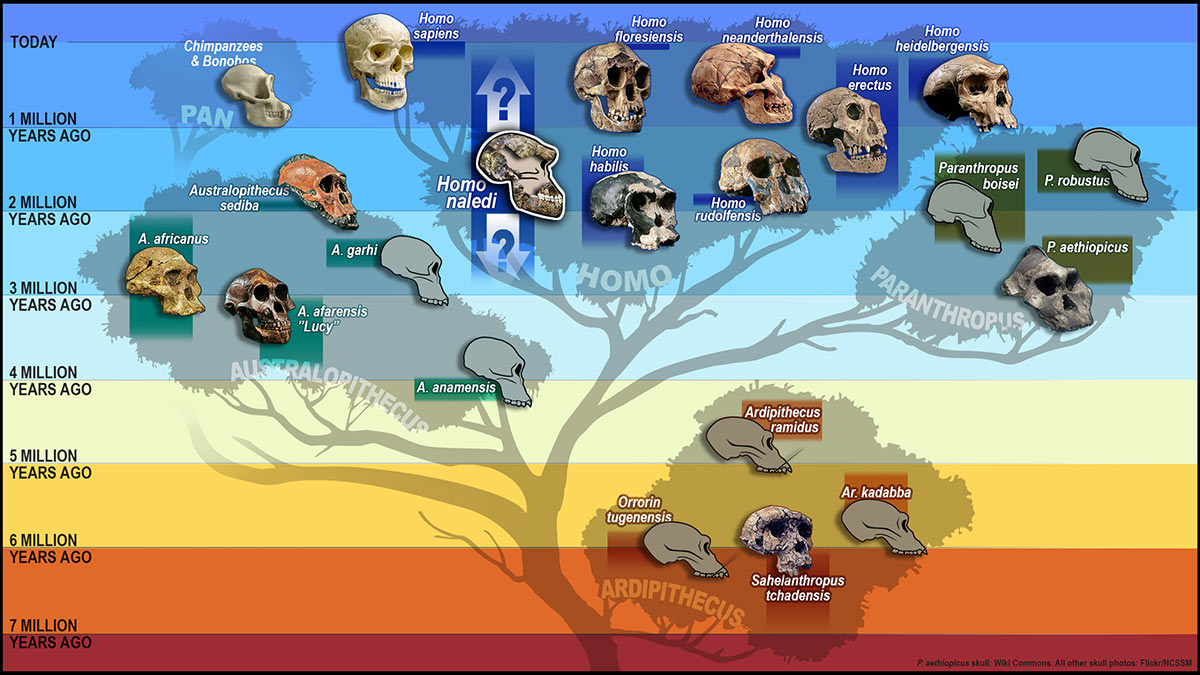
Homo naledi, a newly discovered species in the genus Homo, has now been added to the human family tree. While the fossils of Homo naledi have yet to be dated, the creature may have been a contemporary of modern humans 100,000 years ago — or it may be far older. Illustration: S. V. Medaris, UW–Madison
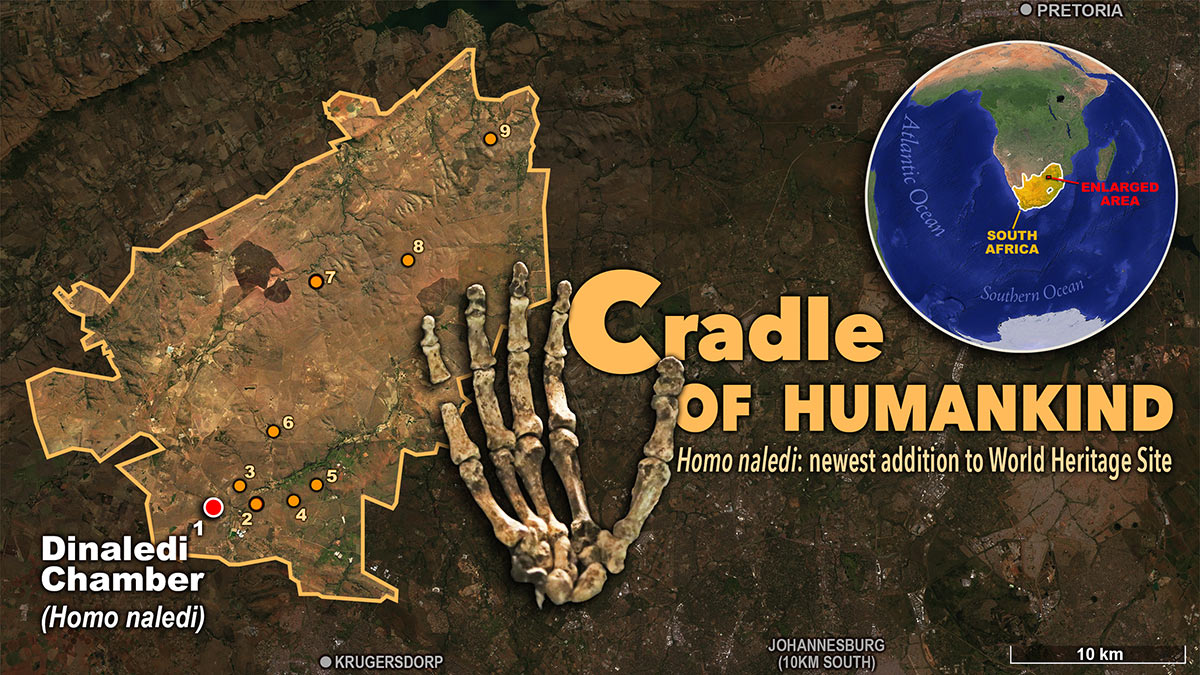
The discovery of a new species in the genus Homo adds to the story of humanity as it emerged and developed on the African continent over millions of years. The spectacular cache of fossils introducing Homo naledi (1 on map) to paleoanthropology was found in close proximity to other critical discoveries in the human family tree. Illustration: S. V. Medaris, UW–Madison
The fossils have yet to be dated. The unmineralized condition of the bones and the geology of the cave have prevented an accurate dating, says Hawks. “They could have been there 2 million years ago or 100,000 years ago, possibly coexisting with modern humans. We don’t yet have a date, but we’re attempting it in every way we can.”
So far, the remains of newborns to the aged have been exhumed from the cave and the researchers expect that many more bones remain in the chamber, which is nearly 100 feet underground and accessible only after squeezing, clambering and crawling 600 feet to a large chamber where the brittle fossils cover the floor.
“We know about every part of the anatomy, and they are not at all like humans,” notes Hawks, who co-directed the analysis of the fossils. “We couldn’t match them to anything that exists. It is clearly a new species.”
Discovering Homo naledi:
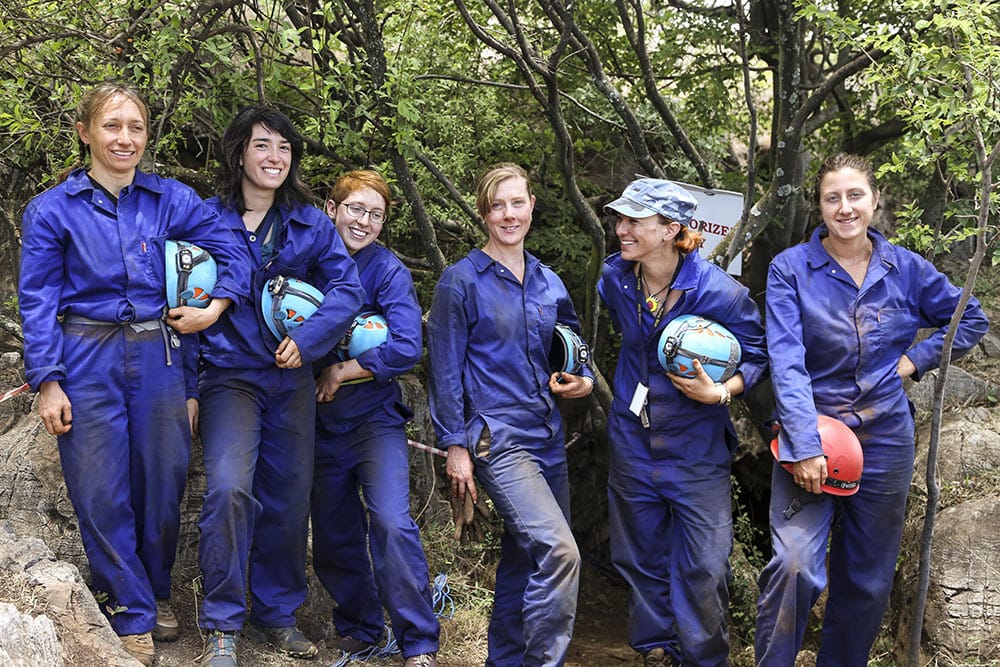
Paleoanthropologists — including Alia Gurtov, second from left, a doctoral candidate in anthropology at UW-Madison — are pictured near the entrance to the cave. Photo: John Hawks, UW–Madison

Dawn at the Rising Star Expedition campsite near Johannesburg, South Africa. The site is part of an area known as the Cradle of Humankind because of the number of important paleoanthropoligic discoveries that have occurred there. Photo: John Hawks, UW–Madison
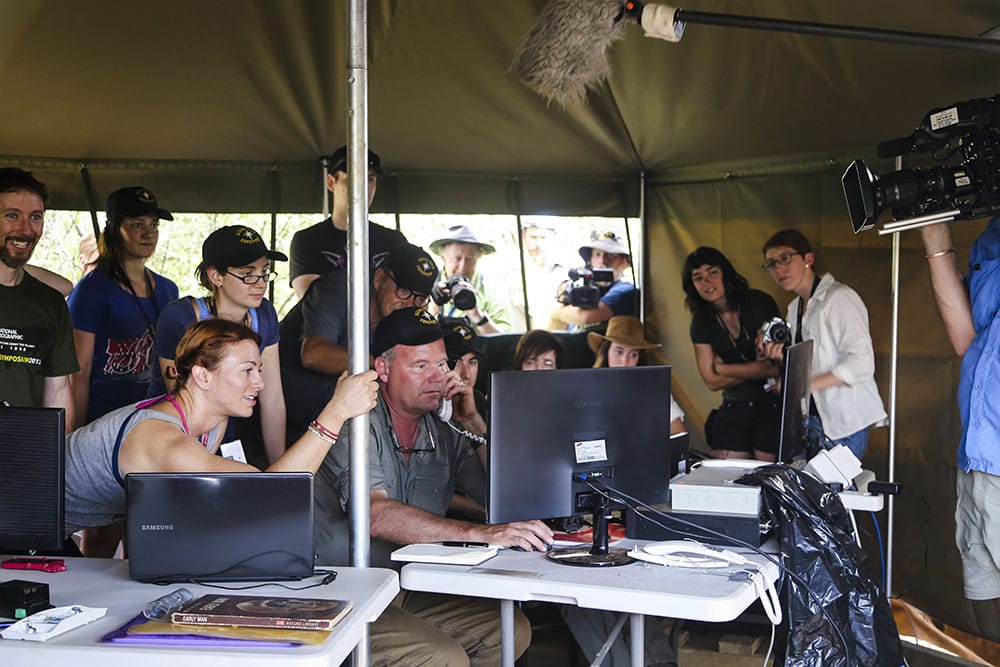
Researchers huddle around University of the Witwatersrand paleoanthropologist Lee Berger, center, to watch live video of cavers entering the first chamber. Photo: John Hawks, UW–Madison
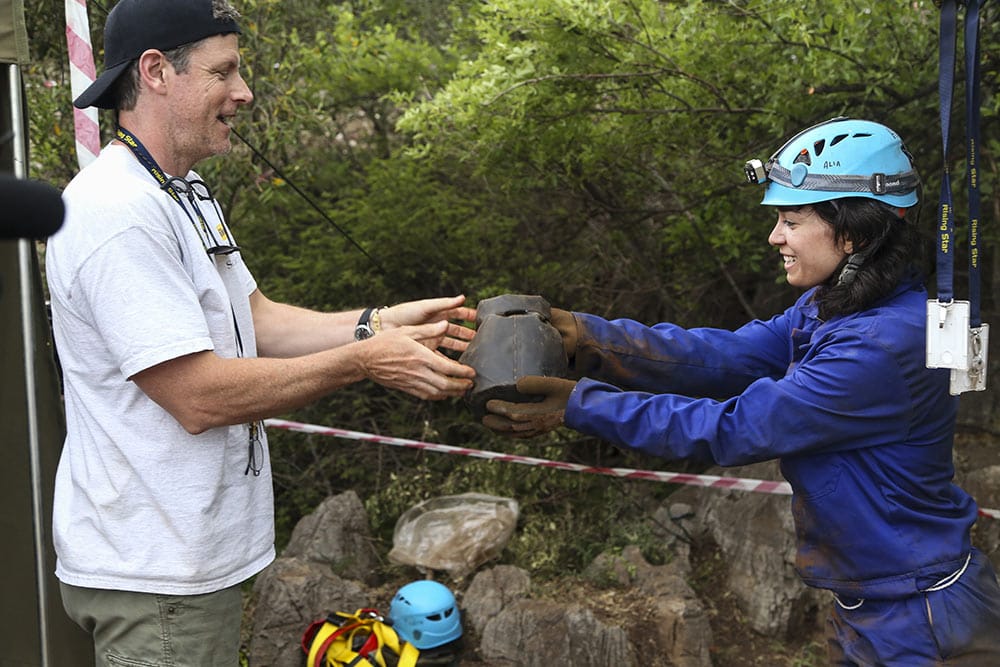
Gurtov hands colleague Steve Churchill a bag of fossils collected from the caves on Nov. 11, 2013. Photo: John Hawks, UW–Madison

Researchers pack fossils brought up form the cave. Photo: John Hawks, UW–Madison
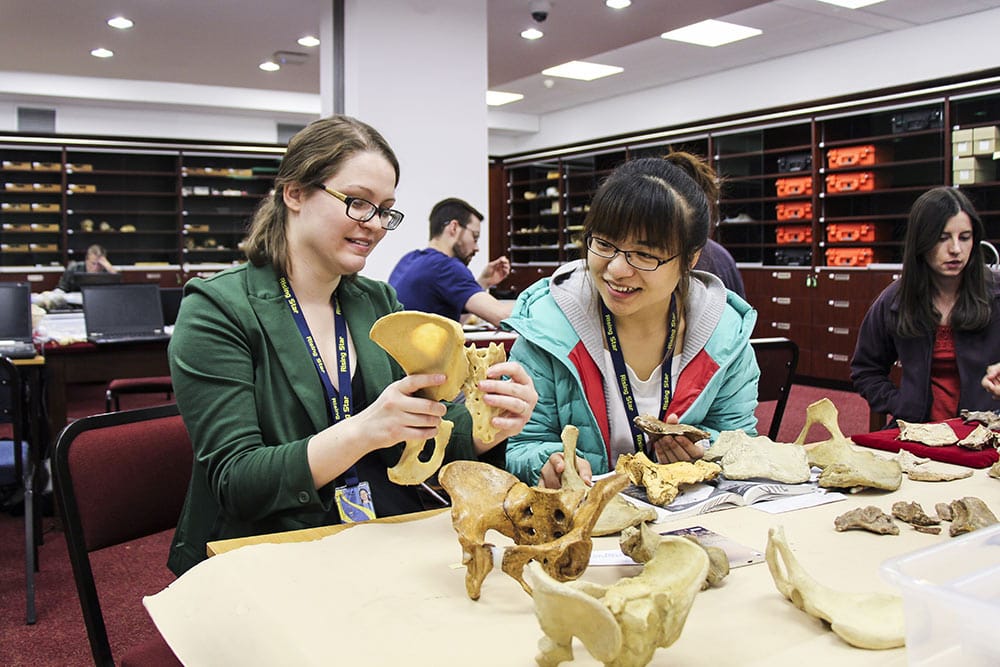
Caroline VanSickle, left, an anthropologist and postdoctoral fellow in gender and women’s studies at UW-Madison, and Pianpian Wei study casts of pelvis fossils from comparative specimens at “hip heaven.” Photo: John Hawks, UW–Madison
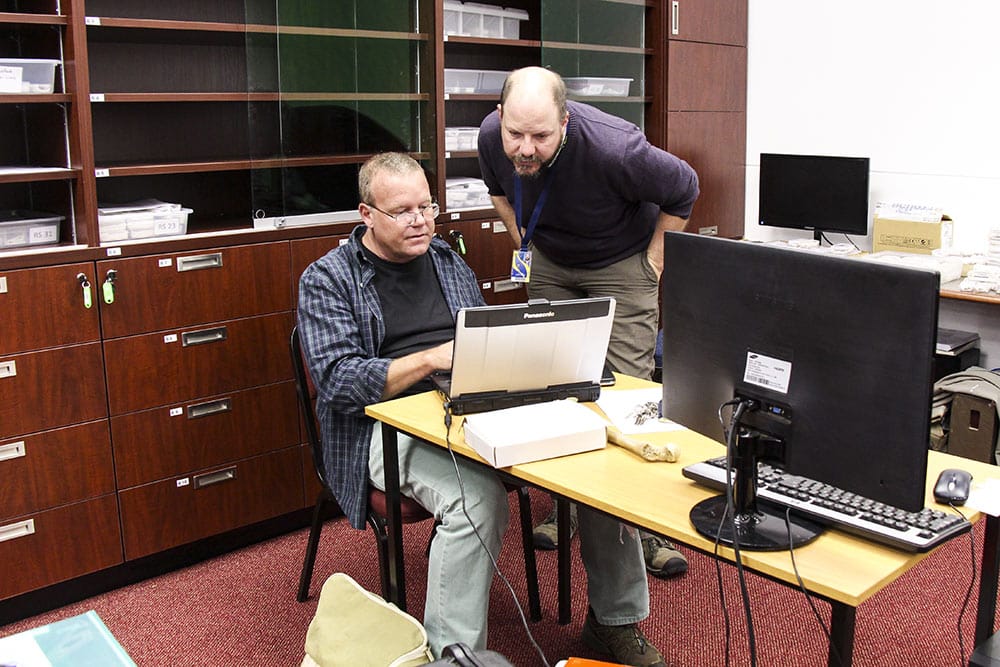
University of the Witwatersrand paleoanthropologist Lee Berger, left, the lead scientist of the Rising Star Expedition, and University of Wisconsin-Madison paleoanthropologist John Hawks work in the Wits bone vault. Photo: John Hawks, UW–Madison
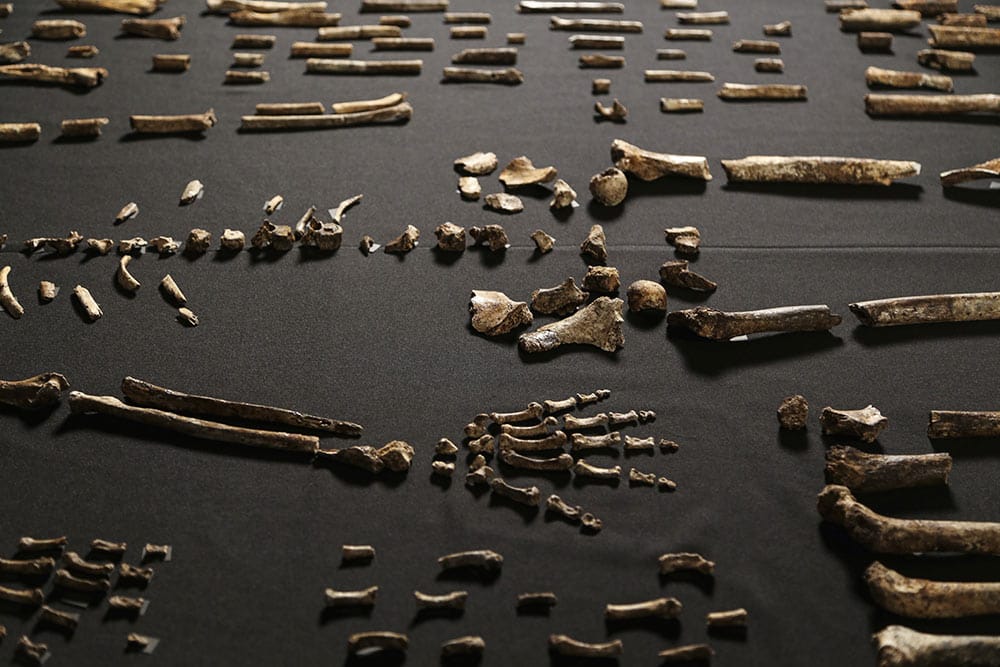
Fossils of Homo naledi are pictured in the Wits bone vault. Photo: John Hawks, UW–Madison
The astonishing find was made initially by amateur cavers and thought at the time to be a single hominin skeleton. The fossils were retrieved by a band of diminutive paleoanthropologists, all women, recruited for their size.
“Naledi” means star in the Sesotho language and is a reference to the Rising Star cave system that includes the chamber, known as the Dinaledi Chamber, where the fossils were found. The circuitous and difficult passage to the chamber narrows at one point to a bare seven inches.
In addition to identifying an entirely new species in the genus Homo, the collections of fossils, which bear no marks from predators or scavengers, are strong evidence that Homo naledi was deliberately interring its dead, according to Hawks, a UW-Madison professor of anthropology.
“We think it is the first instance of deliberate and ritualized interment,” says Hawks. “The only plausible scenario is they deliberately put bodies in this place.”
The cave, according to Hawks, was likely more accessible to Homo naledi than it is today for modern humans. Geochemical tests, however, show that the cave was never open to the surface, raising intriguing questions about the behavior and technologies available to the creatures.
UW–Madison graduate student, Alia Gurtov and, post-doctoral fellow, Caroline Van Sickle, played integral roles in the discovery of Homo naledi.
“We know it was not a death trap,” says Hawks, referring to natural features like hidden sinkholes that sometimes trap and doom creatures over long periods of time. “There are no bones from other animals aside from a few rodents. And there are no marks on the bones from predators or scavengers to suggest they were killed and dragged to the chamber. We can also rule out that it was a sudden mass death.”
Instead, Hawks, Berger and their colleagues believe the chamber was something like a repository. “It seems probable that a group of hominins was returning to this place over a period of time and depositing bodies,” Hawks explains, adding that the supposition that Homo naledi was interring its dead is akin to discovering similar behavior in chimpanzees. “It would be that surprising.”
The way the bodies are arranged and their completeness suggests they were carried to the cave intact. “The bodies were not intentionally covered and we’re not talking about a religious ceremony, but something that was repeated and repeated in the same place. They clearly learned to do this and did it as a group over time. That’s cultural. Only humans and close relatives like Neandertals do anything like this.”
So far, no other organic materials or evidence of fire have been found in the cave complex.
Dating the fossils remains a key problem to solve, says Hawks. “We depend on the geology to help us date things, and here the geology isn’t much like other caves in South Africa. And the fossils don’t have anything within them that we can date. It’s a problem for us.”
One hope, he says, is finding the remains of an animal that may have been a contemporary of Homo naledi. The fossils are embedded in a matrix of soft sediment and there are layers that remain unexcavated.
“It seems probable that a group of hominins was returning to this place over a period of time and depositing bodies.”
John Hawks, UW–Madison
According to Hawks, years of work remain at the site and to document and analyze all of the materials excavated from the Dinaledi Chamber. Plans, he says, include bringing many new technologies to bear on analyzing the fossils to help determine diet, rate of aging and where on the landscape the creatures may have been from.
The project to excavate the fossils was supported by the National Geographic Society, the South African National Research Foundation, the Gauteng Provincial Government. The Wisconsin Alumni Research Foundation also provided support, as did the Texas A&M College of Liberal Arts Seed Grant Program.